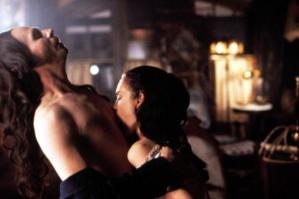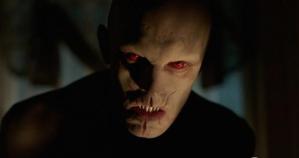Forgive me if this inaugural post is a little academic – I promise they won’t all be – but two novels I read this month have set me to thinking about a difficult subject, and I wanted to try to work it out by writing about it. And if you’ll bear with me while I try to figure this out, there’s a comforting thought at the end of it all. Be forewarned: spoilers abound.
The subject is time – particularly about how two young characters experience time in their dysfunctional fictional universes. Both of these novels are science fiction, of a sort, although both straddle genres: Young Adult, fantasy, fable, romance. Sarah Pinborough’s lyrical The Death House tells the tale of Toby and Clara, teenagers who have been diagnosed with an unspecified illness. In this world, sufferers of this condition “change” in some unspoken, but terrible, way – so carriers of the illness are spirited away to an island location where they can be monitored and, as they begin to fall sick, ‘terminated’ in the middle of the night. This community of teenagers has been forcibly removed from family and home and now live in The Death House under the watchful eye of Matron and her nurses, passing time until their inevitable end.
Antonia Honeywell’s debut novel The Ship tells an alternative, futuristic version of Noah’s Ark. In a not-too-distant world, where ice caps have melted, much of Earth is under water, insects and sea life have died out, and Britain is under emergency military rule, Lalla and her father Michael escape from the terror and near-starvation of life in London on board the ship, an enormous floating idyll that Michael has planned to save five hundred carefully selected people. There is food to last for decades, millions of books to read, leisure activities to take part in, and no danger to fear. But Lalla’s beloved mother has died in the attempt to get to the ship, leaving Lalla grieving and questioning the nature of their ‘salvation.’ For this meticulously orchestrated Eden can’t last forever. At some point, the food will run out. This isn’t a new life – it’s a better way to die. And, although the ship people worship Michael as their saviour, Lalla begins to wonder if the hope of finding a better life on land isn’t preferable to the certainty of a painless, but sterile death on the ship.
These worlds – the drowning, starving world of The Ship and the plague-ridden world of The Death House – are clearly dystopian fictions: Honeywell vividly and frighteningly imagines the endgame of our current environmental crisis, and Pinborough conjures up a society in which sickness is the ultimate taboo, so feared that it must be isolated and eradicated. But The Death House and the ship are not, in themselves, dystopias: they are heterotopias. Not bad places, but other places, alternative places. The French philosopher and historian Michel Foucault describes ‘heterotopia’ as a space of otherness, separate from, but shedding light on, the mechanisms and power structures of ordinary society. Examples he gives are the boarding school, the hospital, the military. His focus is on how these alternative social constructs illuminate the ways in which hegemonic society functions: the authoritarian rule and enforced obedience of a boarding school; the removal of undesirable bodies from a healthy population into a hospitalised alternative population, to allow normal society to go on; the military’s open and necessary violence, on which our supposed ‘peace’ is predicated.
But the ship and The Death House both shed light on a different element of ordinary society: these heteropian places shift the way that time is experienced. Toby and Clara know that their time is limited; Toby’s illicit midnight strolls have shown him how sick teenagers are wheeled away in the night, never to be seen again, and he knows that the same fate awaits all of them. They are living not on borrowed time, but on end-stopped time, though when and how exactly that end will come is not clear to them: “There was no one way to go,” notes Toby, “There are no definite symptoms.” And if the end is both definite and uncertain, the inmates also studiously avoid discussing “before” – the time preceding their incarceration. While they wait in the house, time passes meaninglessly: lessons must be attended, “learning French we’ll never use,” but “if you don’t work and just sit there quietly, the teachers don’t care.” Toby admits that “you end up working anyway, just to pass the time quicker” – though the implications of what will happen at the end of this quickly passing time are left unspoken. Meals, lessons, sleep: the Death House operates according to a rigid routine that makes every day the same, and every day equally meaningless.
Similarly, on the ship, Lalla realises that in giving them the ‘gift’ of a carefree existence, Michael has robbed them of time. Convinced that the ship must have some destination, Lalla insistently asks where they are going, to which the frustrating answer is always “Right here, Lalla. We’re right here, right now.” Space and time become conflated: they are here, now. And that means that in going nowhere, the ship is also not progressing in time. Lalla notices that a group of people on the ship are learning to knit, which she welcomes, because “if there were four pairs of booties where once there had been none, there was proof of the passing of time.” But, maddeningly, when the knitting is finished “they all unravelled the little clothes and wound the balls up again to be knitted into something else.” The ship might offer an Edenic existence for the lucky chosen few, but Lalla realises that perfection can only be maintained if time is frozen.
If time is a measure of change, and no change is possible, then both Toby and Lalla are living in a kind of mad timelessness. Both characters discover that love might offer an escape from their no-time: Toby’s passion for Clara, Lalla’s hopes for happiness with Tom, offer something new, which means that something must have changed and time therefore exists again. However, I was struck by another element in these two books: the clinging to another time to prove the existence of this one. In The Death House, Toby is scornful of one of his fellow inmates who establishes a Christian chapel, but the lure of religion gradually draws many of the teenagers who find some kind of comfort or hope in prayer. Toby hates the idea of religion “because always, always, it highlights that the end is coming. You’ve got to think about after.” Ashley and the “God Squad” are changing time in the house by focusing on a potential future time, and in so doing, they discover the power not only to imagine the future, but to remember the past. While the teenagers normally avoid any mention of their friends who have already been taken away, inside the chapel Toby and Clara discover poignant written commemorations of the teenagers who have died. The practice of religion allows these teenagers to reclaim time, both the future and, through it, the past.
But for Lalla, the inverse happens: while Ashley focuses on the future, Lalla resolves to preserve memory. Her fellow ship people are determined to rid themselves of the horrors of the past, throwing away mementos and keepsakes, but Lalla gathers and salvages vestiges of the past, forming a secret onboard museum of objects that remind her of particular moments. While Tom is prepared to forget his grandfather, and while Michael joyfully declares “If it happened before the ship, then it didn’t happen at all!”, Lalla steadfastly refuses to forget her mother, or the countless suffering people they have left behind. Time continues, for her: others “were no longer counting the days or the weeks or the months,” but Lalla scratches a tally of the passing days on the wall of her cabin. Her father tells her “You’re stuck in the time before,” but Lalla sees that by remembering the past, she is also preserving the future, because it allows her to hope, “Hope that there were still choices to be made,” that her life and death are not predetermined to play out in this sterile, perfect, timeless place. Where The Death House’s Ashley rediscovers the past through his hopes for the future, Lalla finds hope for a better future by preserving the past. They both reject the madness of a timeless heterotopia in order to find time, to embrace and effect change.
The reason this all struck a chord with me, I suppose, is that our lives, here, in this present and real world, obsessively revolve around pasts and futures. We are told from a ridiculously young age that we should be thinking about our future: studying hard so we can go to a good university, going to a good university so we can get a good job, getting a good job so we can buy a house, buying a house so we can have a family, and so on, and so on. The inverse correlation to this frantic planning for the future is the anxiety that so many of us feel, that our pasts were misspent, that we made the wrong choices, that we didn’t plan well enough, that we’ve missed our chance. Unlike Lalla and Toby, we have too much time, or at least, we’re too aware of it, as our busy lives change constantly and as we anxiously worry about next year, the next job, the next home, the next relationship. Oddly, the mad timeless heterotopias in these novels offered a sort of comforting lesson to me: here and there, now and then, it’s not a bad idea to stop and to let time stop; not to plan for the future or fret about the past, but to simply be, without trying to change. To find peace, even for a transient moment, in the thing that Lalla finds so frightening: we’re right here, right now.

